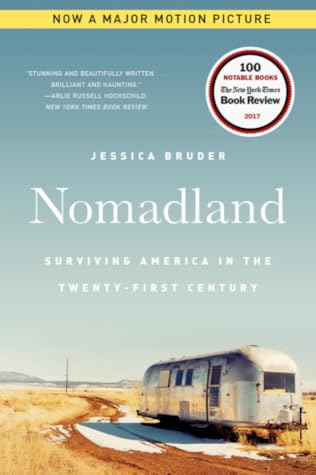More on this book
Community
Kindle Notes & Highlights
There’s no clear count of how many people live nomadically in America. Full-time travelers are a demographer’s nightmare. Statistically they blend in with the rest of the population, since the law requires them to maintain fixed—in other words, fake—addresses. No matter how widely they wander, nomads must be officially “domiciled” somewhere. Your state of residence is where you get vehicles registered and inspected, renew drivers’ licenses, pay taxes, vote, serve on juries, sign up for health insurance (except for those on Medicare), and fulfill a litany of other responsibilities. And living
...more
“We’re facing the first-ever reversal in retirement security in modern U.S. history,” she explained. “Starting with the younger baby boomers, each successive generation is now doing worse than previous generations in terms of their ability to retire without seeing a drop in living standards.”
THE VERY IDEA OF RETIREMENT is a relatively new invention. For most of human history, people worked until they died or were too infirm to lift a finger, at which point they died pretty fast anyway.
After the New Deal, economists began referring to America’s retirement-finance model as a “three-legged stool.” This sturdy tripod was composed of Social Security, private pensions, and combined investments and savings. In recent years, of course, two of those legs have been kicked out. Many Americans saw their assets destroyed by the Great Recession; even before the economic collapse, many had been saving less and less. And since the 1980s, employers have been replacing defined-benefit pensions that are funded by employers and guarantee a monthly sum in perpetuity with 401(k) plans, which
...more
It’s estimated that more than forty thousand RVers dwell in the desert near Quartzsite from December through February.
I’d been interviewing workampers for about six months. In that time, I’d also scoured the media—online, print, and broadcast—for anything about the subculture. Much of what I found made workamping sound like a sunny lifestyle, or even a quirky hobby, rather than a survival strategy in an era when Americans were getting priced out of traditional housing and struggling to make a living wage.
A journalist who parachutes in for an afternoon to cover a story seldom gets close enough to hear any kind of truth.
The truth as I see it is that people can both struggle and remain upbeat simultaneously, through even the most soul-testing of challenges. This doesn’t mean they’re in denial. Rather, it testifies to the remarkable ability of humankind to adapt, to seek meaning and kinship when confronted with adversity.
In the widening gap between credits and debits hangs a question: What parts of this life are you willing to give up, so you can keep on living?
“I am, somehow, less interested in the weight and convolutions of Einstein’s brain than in the near certainty that people of equal talent have lived and died in cotton fields and sweatshops,” reflected the late writer Stephen Jay Gould. A deepening class divide makes social mobility all but impossible. The result is a de facto caste system. This is not only morally wrong but also tremendously wasteful. Denying access to opportunity for large segments of the population means throwing away vast reserves of talent and brainpower.


